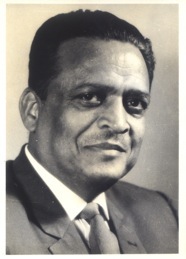DR. W.D. Patwardhan Memorial


DR. W.D. Patwardhan Memorial


Awards and Recognitions
•Fellow of the Royal Institute of Chemistry, (U.K.)
•Chair, committee on Explosives by Indian Standards Institute
•Fellow of the Rocket Society of India
•Fellow of Indian Institute of Chemical Engineers
•Conferred with “Padmashree” by The President of India (1974)
Notable achievements for independent India
•Developed the technology of Charge Line Mine Clearing (CLMC), in the 1960s, which saved thousands of lives in the wars of 1965 and 1971.
•Developed the solid propellant for India’s first rocket, developed by ISRO, which was launched from Thumba.
•Developed the detonation system for India’s first nuclear device (the Smiling Buddha) tested in 1974.
Early Life:
He was born on the 30th of January, 1917 in Jabalpur, Madhya Pradesh. In the 1920s, his parents migrated to Nashik, Maharashtra.
In school and Junior College, he proved to be a brilliant student. Always placing first helped him to earn scholarships. However, he himself never expected to continue education towards a bachelor’s degree, as he was expected to earn to provide for his family after matriculation.
Prof. T. N. Kulkarni of H.P.T. College, advised him to go to Poona (Pune) for pursuing a degree course in science. Aided by scholarships, and under the guardianship and support of his uncle Mr. Vishwanath Joshi, he moved to Pune. There he graduated from S. P. College. He further continued with graduate study in Chemistry and achieved a post graduation in chemistry. Prof. Limaye and Prof. Bhide greatly influenced his philosophy of research work.
Soon after, in 1938, he started working as a Research Assistant for Technical Development Establishment (TDE) at Kirkee, Pune. During this period, he developed his skills in the science of explosives under guidance of Dr. Osborne and Dr. Ambler.
A sudden opportunity after the start of the Second World War, proved a turning point in his professional life. During the Second World War in support of the war effort the TDE was involved in analyzing samples of seized enemy ammunition. Dr. Patwardhan felt that the analysis was being mishandled. He requested permission from Dr. Ambler to work on the sample himself. After getting authorization to do so, he completed the analysis in a short period of time, and forwarded the report to Dr. Ambler. This report was considered as one of the most valuable research work of that period and was later published in “Ordinance Board Proceedings” in London. At that time, Dr. Ambler presciently described him as the future director of the establishment. Dr. Patwardhan himself happened to discover this remark about him, by Dr. Ambler, years later in a service book maintained in the establishment.
He graduated with a Ph.D. from Mumbai University. His Ph.D. thesis was titled “Photo Decomposition of Aromatic Compounds and TNT.”
Second World War
Dr. Patwardhan was known in Kirkee (place near Pune, where an ammunition factory is located) to make the impossible possible. He developed methods to safely destroy explosive wastes in the factory. He carefully carried out a difficult task of destroying unexploded material (Lead Azide) trapped in debris after an accident. He improved manufacturing processes of very hazardous explosives like ‘Lead Azide’.
“Plastic Explosive,” “RDX,” “Lead Stiffnet,” etc., were developed in UK during the war. However, it was not possible to regularly transport this material to India. Dr. Patwardhan developed processes to manufacture these explosives in Indian conditions.
Work after Indian independence
The Ministry of Defense of independent India was busy handling border issues at both the Eastern and Western fronts. Defense Technology was the need of the time. Dr. Patwardhan developed technologies for the armed forces based on his expertise in the science of explosives.
He was nominated as director, for the newly formed laboratory for research in explosives named ERDL (Explosives Research and Development Laboratory), for which, he worked day and night to finalize plans, solving different problems even acquiring lands for the new facilities.
Technology that saved lives
The technology of Charge Line Mine Clearing (CLMC), which he developed in the 1960s saved hundreds and thousands of lives in the wars of 1965 and 1971. This technology continues to be used today. This device can clear mines in a minefield in a straight line by making a mine-free path allowing soldiers to safely march forward.
He developed devices to create smoke screens for providing cover and colored smokes for signaling using guanidine nitrate.
A milestone in technology was achieved when he developed devices for oxygen supply in submarines using potassium super oxide. This was a challenging task, where he developed a process to purify potassium and making super oxide.
He developed the solid propellant for the first rocket developed by ISRO which was launched from Thumba.
He, assisted by his colleague Dr. S. A. Joshi, was also instrumental in developing the detonation system for India’s first nuclear device tested in 1974, a project headed by Dr. Raja Ramanna (ref: Weapons of Peace by Raj Chengappa).
He had good working relations with Defense ministers including Mr. Y. B. Chavan, Mr. Swaran Singh, Army officials like Gen. Bewoor, scientific advisors like Dr. Nagchowdhury and Dr. R.V. Tamhankar (Director DMRL), Dr. Raja Ramanna (Director, BARC).
Dr. Abdul Kalam worked with Dr. W.D. Patwardhan for some time in his early career days.
Dr. Patwardhan’s expertise in the science and technology of explosives was well known even in the western world. Publishers of “Nature” journal requested him to send a review on the textbook of explosives, by Urbanski, and was later published.
The foundations of different propellants and explosives technology for Indian armed forces, were laid in ERDL, by Dr. Patwardhan.
He was recently honored by the High Energy Materials Research Laboratory (HEMRL: new name of ERDL) by naming an auditorium as “Patwardhan Hall.”
Other Areas of Work:
Dr. Patwardhan was keenly interested in agriculture and astronomy.
He wrote a book on practicing hydroponics (agriculture without soil). He performed many experiments in hydroponics, and wrote a book on the topic.
He was one of the founder members of the Rose Society of Poona.
He developed a low cost technology to produce parabolic mirrors for reflecting telescopes used for astronomical observations.
At the age of eighty, Dr. Patwardhan worked on another life saving technology: airbags, used in modern cars, together with Dr. Ramaswamy. He visited the U.S. in 1997 for this purpose.
When he was 86, he successfully developed a method to precipitate an extract of a seed called Semecarpus anacardium (Bhallataka or bibba). This is supposed to be a parallel medicine for cancer.
Philosophy of life
Dr. Patwardhan always valued principles of philosophy in ‘Vedantas’(Upanishads), where an “ultimate being” (Bramha) is described. He did not believe in the theory of reincarnation. He believed that all living and non-living beings emerge from a single infinite soul and they diminish in the same like waves in water.
He wrote and published an essay named “Science and Soul,” where he expressed his views about the quest for the Ultimate Truth.
Dr. Waman Dattatreya Patwardhan
(1917 – 2007)
Space and Defense technology in India has reached a sky high after fifty years of independence. India is now a declared Nuclear Power, and has indigenous and highly developed Space and Missile Programs.
Today’s achievements and successes in these Programs are the result of years of hard work, ingenuity, and excellence in scientific research in these technologies.
Looking back, the foundation stones of the Nuclear Program, the Missile Program and the Space Program were laid in the fifties and sixties. Moreover, it is interesting to study how the foundation stones for today’s successes were laid with great works of a handful of men who stayed away from fame and publicity, as secrecy was the need of the time. Even today, most of them remain in obscurity.
Dr. W. D. Patwardhan was one of those great men, who shaped the Science and
Technology of Armaments and Explosives in DRDO, and laid the foundation stones for India’s indigenous and highly successful Nuclear, Space, and Missile Programs.
He worked as the Director of the Explosives Research and Development Laboratory (ERDL) from 1962 to 1972, and later as the Director of the Armaments Research and Development Establishment (ARDE), from 1972 to 1976.
A Brief Biography

